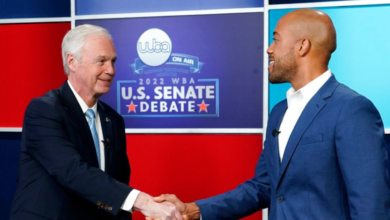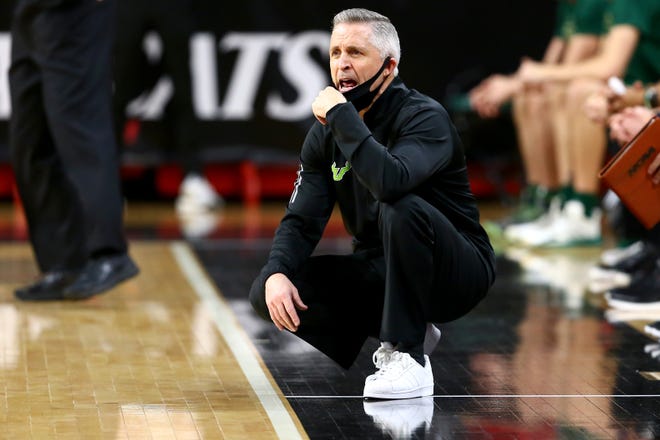
President Joe Biden confirmed Wednesday what many have anticipated for months – a plan to forgive or reduce student loan debt for millions of debt-saddled borrowers.
If you earn less than $125,000 annually, he said, you're eligible to receive cancellation of up to $10,000 in federal student loans. If you received a Pell Grant, you can get up to $20,000 forgiven.
If you're not eligible for any student debt forgiveness, your pause on repayments continues to be paused until year end. The Department of Education is also working on a proposal introducing a new repayment plan to ease the burden on borrowers.
Since the start of the pandemic in 2020, borrowers haven't had to pay a cent on their federal student loans. During this time, the pressure grew for the president to cancel the debt. It was one of the platforms Biden ran on for president in 2020.
Though the plan was welcomed by many, it still garnered criticism. Many had sought higher forgiveness amounts – $50,000 or even all amounts, no matter how large. The total outstanding balance for federally owned (including defaulted) student loans in December 2021 was $1.38 trillion, the New York Federal Reserve said in April.
BIDEN PLAN RECAP:$20K in student debt to be forgiven, extend payment pause
STUDENT LOANS:Why are some people angry about Biden loan program?
How do I apply?
The application will be available mid-October, officials said. Borrowers who provide an email address at studentaid.gov are to receive an email notification when the application is available. Applications can take four to six weeks to process. The pause on federal student loan repayments terminates Dec. 31.
Nearly 8 million borrowers may be automatically eligible to receive relief because relevant income data is already available to the Department of Education.
What’s Biden’s student loan forgiveness plan?
Individuals with an annual income of less than $125,000 (or under $250,000 for married couples or heads of households) are entitled to have up to $10,000 in federal student loans canceled. No private loans will be forgiven.
Those who received a Pell Grant in college will be eligible for up to $20,000 in debt cancellation.
For those who still have student debt, the repayment pause since March 2020 will be extended to the end of the year. Borrowers will resume payments in January.
BIDEN COLLEGE CAREER:Biden mentions own education in loan relief speech
LIFE OFF PAUSE:How the student loan payment pause changed people’s lives
What is a Pell Grant?
Federal funding that’s usually awarded only to students who display exceptional financial need and have not earned a bachelor's, graduate or professional degree. Sometimes, a student enrolled in a post-baccalaureate teacher certification program might receive a Pell Grant.
Unlike a loan, a Pell Grant does not have to be repaid, except under certain circumstances. Those include a change in enrollment status or if you received outside scholarships or grants that reduced your need for federal student aid.
PELL GRANTS:Who qualifies? What to know from Biden student loan plan
Are current students eligible for loan forgiveness?
Loans awarded to current students and graduates with undergraduate, graduate and Parent PLUS loans are eligible, so long as the loans were awarded by June 30, 2022.
What's the cost of student loan forgiveness?
A one-time maximum debt forgiveness of $10,000 per borrower will cost the U.S. government around $300 billion for borrowers with incomes less than $125,000, according to analysis published on Tuesday by Junlei Chen and Kent Smetters at the Penn Wharton Budget Model, based at the University of Pennsylvania. This cost increases to $330 billion if the program continues over the standard 10-year budget window.
Before the announcement, the Government Accountability Office estimated that alone, the payment pause since the start of the pandemic cost the government $102 billion. That amount included suspending all payments due, interest accrual and involuntary collections for loans in default from March 13, 2020, to Aug. 31, 2022.

Who benefits most from the student debt forgiveness plan?
Mostly higher-income households. Between 69% and 73% of the debt forgiven accrues to households in the top 60% of the income distribution, Chen and Smetters said.
A New York Federal Reserve study in April, though, said that the income cap to the forgiveness "substantially reduces the cost of student loan forgiveness and increases the share of benefit going to borrowers who are more likely to struggle repaying their debts."
For example, an income cap of $75,000 for a $10,000 cancellation raises the share of forgiven loan dollars going to borrowers in low-income neighborhoods to 35% from 25% and the share going to lower credit score borrowers to 42% from 37%, it said.
Income caps also increase the share of loans forgiven that were delinquent before the pandemic to 60% from 34%.
LIFE'S NOT FAIR:Is student loan forgiveness fair to those without college degrees? Americans remain divided over costs
AVOIDING STUDENT DEBT:Middle class, minus debt: Apprenticeships, certificates offer low-cost option to college
How many Americans have student loans outstanding?
About 45 million Americans hold federal student loan debt, according to federal data. The loan forgiveness plan should provide relief to about 43 million borrowers and cancel the full remaining balance for nearly 45% of those borrowers.
The total outstanding balance for federally owned (including defaulted) student loans in December 2021 was $1.38 trillion, the New York Federal Reserve said in April.
Most (67%) student loan borrowers are under 40 years old, but 57% of all balances are owed by those under 40. That means those with larger balances are more likely to be older or to have taken out loans for graduate school, it said.
The White House estimates that its initiative will cancel the full remaining balance for roughly 20 million borrowers.
What’s the average outstanding student loan debt amount?
The average federal student loan debt balance is $37,667 while the total average balance (including private loan debt) may be as high as $40,274, according to Education Data Initiative, which collects data and statistics about the U.S. education system.
DISSECTING STUDENT LOANS:Free college or federal student loans? These alternatives could help solve student debt crisis
POLITICAL FORGIVENESS:'Forgiving' student loans isn't motivated by kindness. It's all about cold, hard politics.
Is student loan forgiveness taxable?
The debt relief isn’t counted as taxable income for federal income tax purposes, the White House says.
Would canceling student loan debt increase inflation?
Some prominent economists, including former Treasury Secretary Lawrence Summers and Jason Furman, who was chairman of President Barack Obama’s Council of Economic Advisors, have been vocal critics, saying student debt forgiveness would stoke 40-year high inflation and may be unfair.
“Student loan relief is not free,” Furman tweeted on Aug. 19. “Part of it would be paid for by the 87% of Americans who do not benefit but lose out from inflation. Part of it would be paid for by future spending cuts & tax increases—with uncertainty about who will bear those costs.”
The Committee for a Responsible Federal Budget estimates Biden’s plan “would more than undo the deflationary pressures from the Inflation Reduction Act and add 0.15 percentage points of additional inflation in the near-term,” noted Sarah Foster, Bankrate analyst.
The Federal Reserve has been on an aggressive rate-raising cycle to cool demand, but giving people spending money could stymie that effort.
And those economists aren't the only ones worried. Hit already by hefty inflation, 59% of Americans are concerned student loan forgiveness will make inflation worse, according to a CNBC survey, conducted online by Momentive among a national sample of 5,142 adults from Aug. 4 to 15.
EVERYDAY GETS EXPENSIVE:These everyday items saw the biggest price increases from inflation in July, CPI report shows
JOB WORRIES:With 80% of workers afraid of losing jobs during a recession, business owners trim costs
What is discretionary income?
The money you have left after paying taxes and necessary cost-of-living expenses. It's different from disposable income, which is simply the amount of money you have left after paying taxes.
Knowing what discretionary income is is important because many federal student loan repayment plans are income-driven and have payments that are based on your discretionary income.
DISCRETIONARY INCOME:What is it? Why it matters in student loan repayment.
If you qualify for student debt forgiveness, what should you do with any extra money?
“Student loan forgiveness will likely decrease your monthly payment or get rid of it entirely,” said Dan Casey of Bridgeriver Advisors in Bloomfield Hills, Mich.
Take that freed up money to pay off high-interest debt like credit cards, build up your emergency fund, or invest it in your retirement. Even though today looks brighter, the economy is still on shaky footing.
SHAKY GROUND:Are we in a recession? America's economy stinks no matter what you call it.
INFLATION HELP?:President Biden signs Inflation Reduction Act into law to address climate and health care
Does Congress need to approve Biden's loan forgiveness plan?
The White House says it is using the authority Congress granted the Department of Education to forgive the outstanding federal student loans.
Should I stop paying my student loans now?
The Biden administration has extended the Student Loan Payment Pause through Dec. 31, which allows borrowers to suspend their loan payments with a 0% interest rate. The White House has warned that this will be the final extension.
"It’s time for the payments to resume," Biden said Wednesday.
Borrowers who qualify for the payment pause and loan forgiveness should stop paying off loans if they owe less than the $10,000 cap (or $20,000 cap, for Pell Grant recipients) to take full advantage of the loan forgiveness program.
Others who earn more than $125,000 (or $250,000, for married couples) or have more than $10,000 in loans (or $20,000, for Pell Grant recipients) should be ready to start making loan payments again.
"We recommend to continue making payments for now if you can afford to because these payments go 100% toward principal until January," said Isabel Barrow, director of financial planning at Edelman Financial Engines. "While it’s impossible to know what will happen in the future, such as another forgiveness program, we would not recommend delaying or stopping loan payments in anticipation of future changes."
There is also subset of borrowers who did not have their loans paused. These borrowers should continue to make loan payments "to keep the loan in good standing," according to Ameriprise financial private wealth advisor Rebecca Hall.
Loans not eligible for the COVID-19 payment pause include:
- Nondefaulted Federal Family Education Loan (FFEL) Program loans not held by the Department of Education
- Defaulted and Nondefaulted federal Perkins loans not held by the Department of Education
- Nondefaulted Health Education Assistance Loan (HEAL) loans
- Private student loans
The Department of Education administration did not immediately respond to a request for comment on whether any of these loans would be eligible for the loan forgiveness program.
CAN'T AFFORD IT:Is college worth it? Americans say they value higher education, but it's too expensive for many
I paid off student loans recently. Am I eligible for a refund?
The federal government first announced the student loan payment pause on March 13, 2020. The U.S. Department of Education says borrowers who made payments during the pause – including auto-debit payments – can request a refund with their loan servicer.
Borrowers can look up their loan servicer on the agency’s website.
If you don’t qualify, should you start repaying in January?
“If you haven’t made a student loan payment since the pause began, it’s important to understand how much you’ll owe each month,” Daniel Milan, advisor at Cornerstone Financial Services, said.
Then, review the interest rates on your loans and start paying off the highest interest ones first, enrolling in autopay so you don’t miss any payments while you get back into the habit of paying regularly and consider refinancing if it lowers your payments.
“Moving multiple loans into one loan can also help you keep better track of how much you actually owe,” he said.
STOKING INFLATION?:How soaring inflation is complicating Biden's decision whether to forgive student loan debt
What’s ahead for future borrowers?
To “substantially” reduce future monthly payments for lower- and middle-income borrowers and protect more income from loan payments, the Department of Education is proposing a new income-driven repayment plan.
Here are some things being proposed:
- Cutting the amount borrowers have to repay each month and curbing interest so a balance won't grow so long as borrowers make their required monthly payments.
- Loan balance forgiveness after 10 years, instead of 20, under many income-driven repayment plans for borrowers with original loan balances of $12,000 or less. This will allow nearly all community college borrowers to be debt-free within 10 years, the White House said.
- Starting next summer, the Department of Education can automatically pull borrower’s income information each year, avoiding the hassle of needing to recertify their income annually and make it easier for borrowers to stay enrolled.
- Public servants will also have an easier time claiming credits for time of service to go toward debt relief under the Public Service Loan Forgiveness (PSLF) program. The Department of Education has already made some temporary changes toward that end. To apply for forgiveness or payments to count toward forgiveness under the temporary changes, visit the PSLF Help Tool.
A full list of proposed regulations will be published in the coming days on the Federal Register, and the public is invited to comment on the draft rule for 30 days.
TRUE COST OF COLLEGE:It's not just tuition and fees: College students are facing increasingly high rent prices, too
LIFE OFF PAUSE:How the student loan payment pause changed people’s lives
Would Parents PLUS loans be forgiven?
Parent PLUS loans are federal student loans issued directly to parents with dependents in school, meant to supplement school, state and other federal financial aid offered for a dependent undergraduate student enrolled at least half-time.
Parent PLUS loans held by the Department of Education are included in the cancellation policy, along with federal graduate and undergraduate loans.
What’s being done to keep the cost of college from spiraling?
The Department of Education will publish an annual watch list of programs with the worst debt levels in the country, so students registering for the next academic year can steer clear of programs with poor outcomes. It will also request plans from colleges with the most concerning debt outcomes on how they intend to lower debt levels.
Medora Lee is a money, markets and personal finance reporter at USA TODAY. You can reach her at [email protected] and subscribe to our free Daily Money newsletter for personal finance tips and business news every Monday through Friday morning.
Source link








